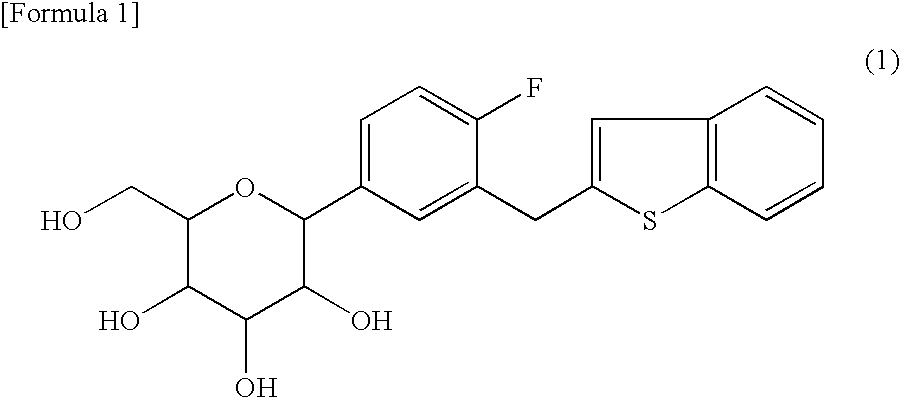Method for producing C-glycoside derivative and intermediate for synthesis thereof
a technology of c-glycoside and derivative, which is applied in the field of producing a c-glycoside derivative, can solve the problems of method, method, yield and cost, and method that is not industrially satisfactory in yield and cost, and achieves low cost and high yield
- Summary
- Abstract
- Description
- Claims
- Application Information
AI Technical Summary
Benefits of technology
Problems solved by technology
Method used
Image
Examples
reference example 1
First step: synthesis of 1-benzothien-2-yl(5-bromo-2-fluorophenyl)methanol
[0047]Into a tetrahydrofuran (20 ml) solution of benzo[b]thiophene (5.0 g) was dropwise added a n-hexane solution (25 ml) of n-butyl lithium (1.58 M) at −78° C. in an argon atmosphere, followed by stirring at −78° C. for 10 minutes. Into this solution was dropwise added a tetrahydrofuran (80 ml) solution of 5-bromo-2-fluorobenzaldehyde (8.0 g), followed by stirring at −78° C. for 2.5 hours. The temperature of the reaction mixture was elevated to room temperature. Water was added thereto, followed by extraction with ethyl acetate. The organic layer was washed with a saturated aqueous sodium chloride solution, dried over anhydrous magnesium sulfate, filtered, and concentrated. The residue was purified by silica gel column chromatography (n-hexane / ethyl acetate) to obtain 1-benzothien-2-yl(5-bromo-2-fluorophenyl)methanol (10.5 g, yield: 83.6%).
[0048]1H-NMR (CDCl3): δ 2.74 (1H, d), 6.35 (1H, d), 6.93 (1H, dd), 7.1...
reference example 2
Synthesis of 2-(5-bromo-2-fluorobenzyl)-1-benzothiophene [synthesis of compound (4)]
[0061]In the third step of the production method of the present invention, when a compound (4) is separated out as crystals, a seed crystal of 2-(5-bromo-2-fluorobenzyl)-1-benzothiophene may be added. The seed crystal added in this case can be produced as follows.
[0062]A dioxane (1.1 liters) solution of 2-[(5-bromo-2-fluorophenyl)(chloro)methyl]-1-benzothiophene (551 g) was added to a dioxane (3.3 liters)-water (1.6 liters) solution of sodium borohydride (410 g) and sodium hydroxide (31 g) at 60 to 66° C., followed by stirring at 52 to 60° C. for 39 hours. To the reaction mixture was added toluene (5.5 liter), water (3.8 liters) and 36% hydrochloric acid (620 ml) to conduct extraction. The organic layer was subjected to distillation under reduced pressure to distil off the solvent. The residue was dried under reduced pressure. The obtained crystals were dissolved in 2-propanol (1 liter) and methanol ...
example
First step: Synthesis of 1-benzothien-2-yl(5-bromo-2-fluorophenyl)methanol
[0064]Into a tetrahydrofuran (100 liters) solution of benzo[b]thiophene (17.4 kg) was dropwise added a n-hexane solution (56.2 kg) of n-butyl lithium (15.08%) in an argon atmosphere at −24.2 to −13.5° C., followed by stirring at −22.1 to −13.5° C. for 40 minutes. Into this solution was dropwise added a tetrahydrofuran (18 liters) solution of 5-bromo-2-fluorobenzaldehyde (25.5 kg) at −22.1 to −11.8° C., followed by stirring at −23.5 to −16.1° C. for 2 hours. To the reaction mixture were added water (100 liters), toluene (130 liters) and 38% hydrochloric acid (12.3 kg), and extraction was conducted. The organic layer was washed with water (130 liters) and then subjected to distillation at normal pressure to distill off the solvent until the residue became 100 liters. Toluene (130 liters) was added to the residue and the mixture was subjected to distillation at normal pressure to distil off the solvent until the ...
PUM
| Property | Measurement | Unit |
|---|---|---|
| temperature | aaaaa | aaaaa |
| temperature | aaaaa | aaaaa |
| temperature | aaaaa | aaaaa |
Abstract
Description
Claims
Application Information
 Login to View More
Login to View More - R&D
- Intellectual Property
- Life Sciences
- Materials
- Tech Scout
- Unparalleled Data Quality
- Higher Quality Content
- 60% Fewer Hallucinations
Browse by: Latest US Patents, China's latest patents, Technical Efficacy Thesaurus, Application Domain, Technology Topic, Popular Technical Reports.
© 2025 PatSnap. All rights reserved.Legal|Privacy policy|Modern Slavery Act Transparency Statement|Sitemap|About US| Contact US: help@patsnap.com



